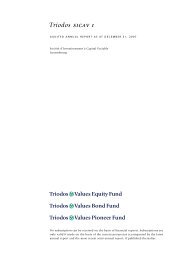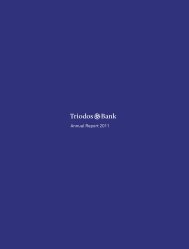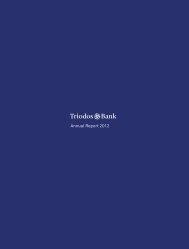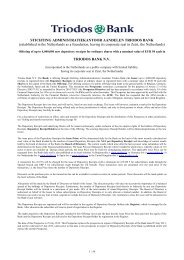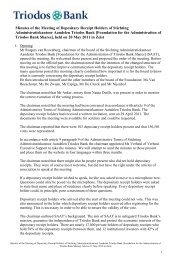TlB Annual Report 2009 - Triodos Bank
TlB Annual Report 2009 - Triodos Bank
TlB Annual Report 2009 - Triodos Bank
You also want an ePaper? Increase the reach of your titles
YUMPU automatically turns print PDFs into web optimized ePapers that Google loves.
alance sheet and profit and loss are<br />
denominated in gbp. Open foreign currency<br />
positions during <strong>2009</strong> have always been close<br />
to zero. The foreign exchange rate risk is<br />
monitored monthly in the Asset and Liability<br />
Committee. Limits are agreed by <strong>Triodos</strong> <strong>Bank</strong>’s<br />
Executive Board based on a proposal made by<br />
the Risk Management Department.<br />
The Interest Rate Risk is the risk that the value<br />
of assets and liabilities is negatively affected by<br />
interest rate changes in the financial markets.<br />
This risk is inherent to the banking business.<br />
The interest rate risk mainly arises from the fact<br />
that there are differences in fixed-rate interest<br />
periods for assets and liabilities.<br />
Every month, <strong>Triodos</strong> <strong>Bank</strong>’s interest rate risk<br />
position is monitored and assessed by the Asset<br />
and Liability Committee. The interest rate risk<br />
is managed using a system of guidelines and<br />
limits and by performing various interest rate<br />
scenarios integrated in the interest rate risk<br />
model. Limits are agreed by <strong>Triodos</strong> <strong>Bank</strong>’s<br />
Executive Board based on a proposal made by<br />
the Risk Management Department. <strong>Triodos</strong><br />
<strong>Bank</strong> uses two key indicators to measure the<br />
interest rate risk. The first is a short term<br />
indicator, the Earnings at Risk (the change of<br />
interest earnings over 12 months in case of an<br />
interest shock of 2%). The second is a long<br />
term indicator, the Economic Value of Equity at<br />
Risk. The Economic Value of Equity is the<br />
difference between the net present value of the<br />
cash flows of all assets and liabilities. The<br />
Economic Value of Equity at Risk is the change<br />
of value of the Economic Value of Equity in<br />
case of an interest rate shock of 2%. The value<br />
of the indicators for interest Earnings at Risk<br />
and the Economic Value of Equity at Risk<br />
according to various interest rate scenarios at<br />
31 December <strong>2009</strong>, are presented in the table<br />
below.<br />
These calculations include a number of<br />
assump tions with respect to current account<br />
and savings deposits that have no contractual<br />
fixed term period. The following assumptions<br />
are made in our savings model:<br />
• Savings deposits ≥ eur 50,000 and gbp savings<br />
deposits decrease in a straight line for one year<br />
• Savings deposits < eur 50,000 decrease in a<br />
straight line over four years<br />
• Euro current accounts credit balances with a<br />
interest rate percentage of < 0.5% decrease in a<br />
straight line over four years<br />
• Other current account credits have an interest<br />
rate period of one month.<br />
A mixture of long and short-term market<br />
interest rates is used for the calculation of<br />
saving deposits interest rates. Interest rates on<br />
the current account are in line with short-term<br />
market rates.<br />
The aforementioned assumptions are initially<br />
based on qualitative grounds, a so-called expert<br />
opinion. To improve the substantiation of the<br />
assumption, a quantitative assessment of the<br />
interest sensitivity of our saving accounts was<br />
executed in most branches. The findings of this<br />
assessment will be used to optimise the savings<br />
model that is used as input for the interest rate<br />
model in 2010. Besides that, a high level risk<br />
assessment compared our savings and interest<br />
rate risk model with industry best practices.<br />
Indicators Earnings at Risk and Economic Value of Equity at Risk at 31 December <strong>2009</strong>, determined per currency<br />
in millions of EUR<br />
Indicator Rising interest rate<br />
(+200 bp)<br />
Decreasing interest rate<br />
(-200 bp)<br />
EUR Earnings at Risk 1 year 5.5 ( 9%) -2.5 (-4%)<br />
GBP Earnings at Risk 1 year 2.3 (28%) -0.5 (-6%)<br />
All currencies Earnings at Risk 1 year 7.8 (11%) -3.0 (-4%)<br />
EUR Economic Value of Equity at Risk -37.9 (-11%) 60.0 (17%)<br />
GBP Economic Value of Equity at Risk 0.1 (2%) 2.1 (64%)<br />
All currencies Economic Value of Equity at Risk -37.8 (-11%) 62.1 (17%)<br />
bp = basis points<br />
TRIODOS BANK - ANNUAL REPORT <strong>2009</strong> 57




